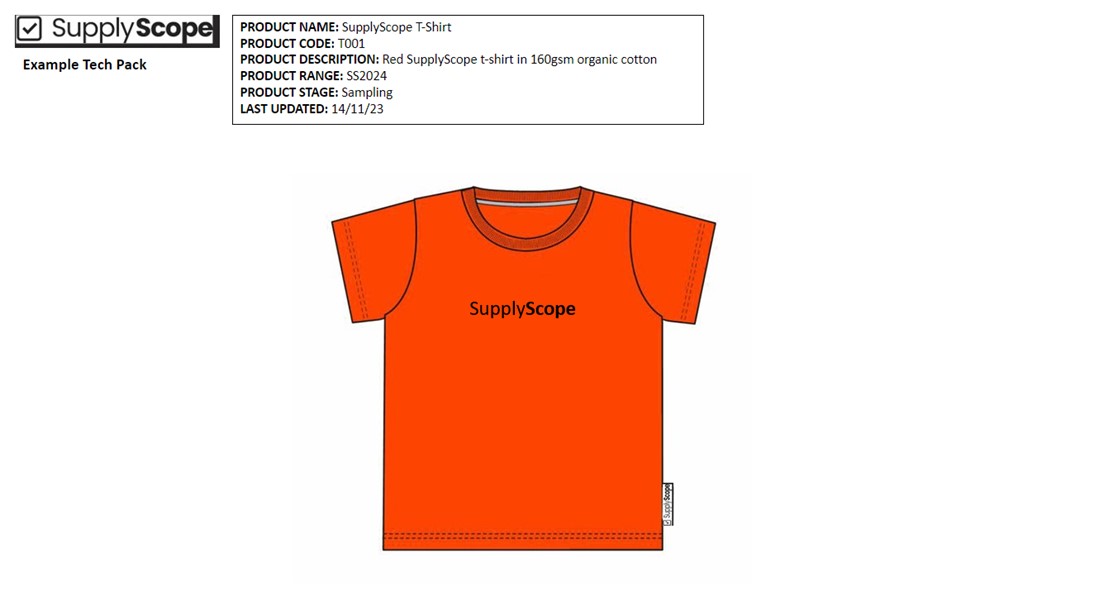What is a Tech Pack?
A tech pack or technical pack is a blueprint of your product containing all the technical specifications needed to make your garment. It's an essential document for both designers and production teams when producing new collections, as it helps clearly communicate every little detail about what you are making, to your manufacturer.
Many designers, however, often overlook or rush through this document dismissing it as unimportant, leading to costly mistakes and delays. The quality of your product will heavily depend on the quality of your tech pack. In this post, we’ll cover the fundamentals of creating the perfect tech pack first time and illustrate how the use of digital tech packs can simplify this process.
SupplyScope allows you to collaborate with your team to create moodboards and tech packs in minutes, which you can share directly with your manufacturing partner.
Why is a tech pack important?
-
Saves time and money
Tech packs clearly communicate your product to your manufacturer reducing the scope for mistakes and therefore, the number of samples a manufacturer may need to produce
A good tech pack will also provide manufacturers with enough details to easily assess the requirements of your product and provide more accurate price quotations.
Ultimately, taking the time to produce a quality tech pack will save time and money as you bring that product to market.
-
Quality Control
Quality control is super important when launching a new fashion product. A comprehensive tech pack will act as a one-stop reference point when assessing the quality of samples and bulk product. By referencing your tech pack, you will be easily able to identify manufacturing errors. Tech packs can be particularly helpful when it comes to perfecting fit quality and ensuring products are within tolerance.
-
Easier Collaboration
By assembling all the details relating to your product in one place it makes it easier for collaboration from team members from across your business. With Tech packs acting as a universal language for fashion product development, it also provides an easy translation for your manufacturer.
What does a good tech pack include?
-
Product Summary: a brief overview of the garment. It should include all the key details relating to your product such as the product name, product code, product description and details of the products development stage and last modification date.
 Example overview of a techpack
Example overview of a techpack -
Technical drawings: Annotated flat drawings showing a front and back view and close-ups of any design details such as pockets, pleats, seams, and stitching details. These drawings should include labels for product dimensions and the size and placement of each component.
 Example of point of measurement for your measurement specification below.
Example of point of measurement for your measurement specification below. -
Measurement & Grading Specifications: This section should contain all the necessary measurements to accurately build your product for all sizes. There should also be a tolerance range which indicates the acceptable margin of error for fit quality.
 Example of measurement by sizes of a t-shirt and setting up tolerance expectation to factories.
Example of measurement by sizes of a t-shirt and setting up tolerance expectation to factories. -
Construction Details: Construction details define how the garment should be put together. It should supplement your technical drawings and indicate any specific details that the manufacturer needs to be aware of, to build the garment in-line with your desired result.
-
Bill of Materials (BOM): This contains all the information on each key material that makes up your product including name, colourways, composition, weight, finish, and a nominated supplier if you have one. It will also need to include information on each component that makes up your product – embroideries, prints, labels, buttons, tags, threads, trims, fastenings and embellishments.
 Example Bill of Materials table in a techpack
Example Bill of Materials table in a techpack -
Care Information: This section will often be supplemented by information from the manufacturer. It must contain all the necessary information for the end consumer to effectively clean and maintain your product.
-
Cost Sheet: A detailed breakdown of all the costs associated with the manufacturing of your product. It should give manufacturers an accurate indication of what the raw materials will cost to make your product and will help you to anticipate your sale price or margin.
-
Comments & feedback: This section is important once the product reaches its sample phase and allows any amendments to be recorded in one place. This way manufacturers can easily identify what changes they need to make, based on previous feedback.
How to make a fashion tech pack?
When it comes to making your tech pack, it is important that you have access to the necessary tools and an in-depth concept for your product. Conventionally, the two main tools which can be used to make your tech pack are Microsoft excel and Adobe Illustrator.
Although these are great tools that are easily customisable and quick for teams to learn, they are not built with the unique needs of fashion product development in mind. Although it may seem easier at first to create a tech pack in Adobe, Excel or Powerpoint, problems arise with these tools as the product evolves through the product development process.
What are the key challenges with current tools?
-
Harder for Collaboration:Tech Packs are collaborative documents, both your team and your manufacturer need to be able to edit, comment on or modify details. This is not so easy to do on read-only attachments, .pdfs, or offline documents. Comments and changes need to be made in real-time and the latest version needs to be easily identifiable.
 Example issue of where multiple techpack final file being stored in a folder
Example issue of where multiple techpack final file being stored in a folder -
Risk of making costly mistakes:Tech packs made using Excel or similar tools are either attached to an email or uploaded to a platform like We Transfer. This increases the possibility of the files not being sent to the right individuals, or in some cases, the link expiring! This method also makes it easy to attach the wrong version and a critical piece of sample feedback forgotten. These small human errors can be very costly once your product reaches the production stage.
-
Miscommunication:Manufacturers sometimes find it difficult to interpret every unique tech pack for every brand they produce for. It’s easier for them if there is a certain degree of standardization across all the tech packs they receive. This would inevitably minimise the potential for mistakes and would make working with your manufacturer an easier process.
Why modern product developers are moving to digital tech packs?
Digital tools provide you with all the essential resources to instantly build detailed and clean tech packs in one purpose-built platform. Their cloud-based software makes it super easy for your product development team to collaborate on pieces and makes sharing your tech pack with manufacturers reliable and easy.

Major benefits of digital tech packs
-
Faster to create: Create tech packs in minutes with the option to drag and drop components from existing products.
-
Easy to revise: Instantly revise all elements of your tech pack in one place. No need to navigate multiple tools and files.
 Markup and Annotate your product measurement in SupplyScope App
Markup and Annotate your product measurement in SupplyScope App -
Intuitive to use: Simple and convenient lay-out that allows any-level of user to quickly familiarise themselves.
 Managing Product Measurement of your digital techpack via SupplyScope
Managing Product Measurement of your digital techpack via SupplyScope -
Easy to share: Instantly share up-to-date copies of your tech pack with one click.
-
Real-time collaboration: Allow multiple team members to update, revise or communicate simultaneously in one place.
-
One up-to-date copy: with automatic updates, never worry about the wrong version ending up with your manufacturer.
-
Extensive library of resources and templates: get inspired and use our extensive card library of measurements, materials and components to instantly build and customise your own products in minutes.
 SupplyScope Setup Library of Component Cards
SupplyScope Setup Library of Component Cards


